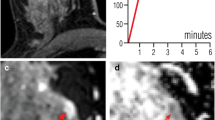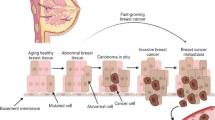Abstract
Purpose
To determine the malignancy rate for MRI-guided breast biopsies performed for T2 hyperintense breast lesions and to assess additional clinical and MRI characteristics that can predict benign and malignant outcomes.
Methods
A retrospective chart review of consecutive MRI-guided breast biopsies performed in two tertiary hospitals was conducted over two years. Biopsies performed for T2 hyperintense lesions were selected, and further lesion imaging characteristics and patient risk factors were collected. Univariate and multivariate modeling regression were used to determine additional imaging and patient factors associated with malignant outcomes for biopsies of T2 hyperintense lesions.
Results
Out of 369 MRI-guided breast biopsies, 100 (27%) were performed for T2 hyperintense lesions. Two biopsy-proven benign lesions were excluded as the patient was lost on follow-up. With a study cohort of 98 lesions, the final pathology results were benign for 80 (80%) of these lesions, while 18 (18%) were malignant. Using multivariate logistic modeling, patient age > 50 (OR 5.99 (1.49, 24.08 95% CI), p < 0.05) and lesion size > 3 cm (OR 5.54 (1.54–18.7), p < 0.01) were found to be important predictors of malignant outcomes for MRI biopsies performed for T2 hyperintense lesions.
Conclusion
Our study observed a high malignancy rate, challenging the assumption that T2 hyperintensity can be considered a benign imaging characteristic for otherwise suspicious MRI-detected lesions. Decision-making regarding tissue sampling should be made based on a thorough evaluation of more reliable additional demographic and imaging factors, including patient age and lesion size.
Key messages
-
Increasing patient age and increasing target lesion size are important predictors of a malignant breast biopsy for T2 hyperintense lesions.
-
Lesion T2 intensity should be assessed for every target; however, additional imaging and clinical features should be used to guide decision-making regarding the need for tissue sampling.




Similar content being viewed by others
Data availability
The datasets generated during and/or analyzed during the current study are not publicly available but are available from the corresponding author on reasonable request.
References
Mann RM, Cho N, Moy L (2019) Breast MRI: state of the art. Radiology 292(3):520–536. https://doi.org/10.1148/radiol.2019182947
D’Orsi C, Sickles E, Mendelson EB, Morris E (2013) ACR BI-RADS® Atlas, Breast Imaging Reporting and Data System. American College of Radiology, Reston, VA
Gibson AL, Watkins JE, Agrawal A, Tyminski MM, DeBenedectis CM (2022) Shedding light on T2 bright masses on breast MRI: benign and malignant causes. J Breast Imaging 4(4):430–440. https://doi.org/10.1093/jbi/wbac030
Sharma S, Nwachukwu C, Wieseler C, Elsherif S, Letter H, Sharma S (2021) MRI virtual biopsy of T2 hyperintense breast lesions. J Clin Imaging Sci 11:18. https://doi.org/10.25259/JCIS_42_2021
Westra C, Dialani V, Mehta TS, Eisenberg RL (2014) Using T2-weighted sequences to more accurately characterize breast masses seen on MRI. Am J Roentgenol 202(3):W183–W190. https://doi.org/10.2214/AJR.13.11266
Santamaría G, Velasco M, Bargalló X, Caparrós X, Farrús B, Luis FP (2010) Radiologic and pathologic findings in breast tumors with high signal intensity on T2-weighted MR images. Radiographics 30(2):533–548. https://doi.org/10.1148/rg.302095044
Yuen S, Uematsu T, Kasami M et al (2007) Breast carcinomas with strong high-signal intensity on T2-weighted MR images: pathological characteristics and differential diagnosis. J Magn Reson Imaging 25(3):502–510. https://doi.org/10.1002/jmri.20845
Taskin F, Soyder A, Tanyeri A, Ozturk VS, Unsal A (2017) Lesion characteristics, histopathologic results, and follow-up of breast lesions after MRI-guided biopsy. Diagn Interv Radiol 23(5):333–338. https://doi.org/10.5152/dir.2017.17004
Spick C, Schernthaner M, Pinker K et al (2016) MR-guided vacuum-assisted breast biopsy of MRI-only lesions: a single center experience. Eur Radiol 26(11):3908–3916. https://doi.org/10.1007/s00330-016-4267-9
Ferré R, Ianculescu V, Ciolovan L et al (2016) Diagnostic performance of MR-guided vacuum-assisted breast biopsy: 8 years of experience. Breast J 22(1):83–89. https://doi.org/10.1111/tbj.12519
Malhaire C, El Khoury C, Thibault F et al (2010) Vacuum-assisted biopsies under MR guidance: results of 72 procedures. Eur Radiol 20(7):1554–1562. https://doi.org/10.1007/s00330-009-1707-9
Liberman L, Bracero N, Morris E, Thornton C, Dershaw DD (2005) MRI-guided 9-gauge vacuum-assisted breast biopsy: initial clinical experience. Am J Roentgenol 185(1):183–193
Perlet C, Heywang-Kobrunner SH, Heinig A et al (2006) Magnetic resonance-guided, vacuum-assisted breast biopsy: results from a European multicenter study of 538 lesions. Cancer 106(5):982–990. https://doi.org/10.1002/cncr.21720
Özcan BB, Yan J, Xi Y, Baydoun S, Scoggins ME, Doğan BE (2022) Performance benchmark metrics and clinicopathologic outcomes of MRI-guided breast biopsies: a systematic review and meta-analysis. Eur J Breast Health 19(1):1–27. https://doi.org/10.4274/ejbh.galenos.2022.2022-12-1
Kuhl CK, Klaschik S, Mielcarek P (1999) Do T2-weighted pulse sequences help with the differential diagnosis of enhancing lesions in dynamic breast MRI? J Magn Reson Imaging 9(2):187–196
Grimm LJ, Enslow M, Ghate SV (2019) Solitary, well-circumscribed, t2 hyperintense masses on MRI have very low malignancy rates. J Breast Imaging 1(1):37–42. https://doi.org/10.1093/jbi/wby014
Aydin H (2019) The MRI characteristics of non-mass enhancement lesions of the breast: associations with malignancy. Br J Radiol 92(1096):20180464. https://doi.org/10.1259/bjr.20180464
Fujiwara K, Yamada T, Kanemaki Y et al (2018) Grading system to categorize breast MRI in BI-RADS 5th edition: a multivariate study of breast mass descriptors in terms of probability of malignancy. Am J Roentgenol 210(3):W118–W127. https://doi.org/10.2214/AJR.17.17926
Grimm LJ, Anderson AL, Baker JA et al (2015) Frequency of malignancy and imaging characteristics of probably benign lesions seen at breast MRI. Am J Roentgenol 205(2):442–447. https://doi.org/10.2214/AJR.14.13530
Ha R, Sung J, Lee C, Comstock C, Wynn R, Morris E (2014) Characteristics and outcome of enhancing foci followed on breast MRI with management implications. Clin Radiol 69(7):715–720. https://doi.org/10.1016/j.crad.2014.02.007
Gutierrez RL, DeMartini WB, Eby PR, Kurland BF, Peacock S, Lehman CD (2009) BI-RADS lesion characteristics predict likelihood of malignancy in breast MRI for masses but not for nonmasslike enhancement. Am J Roentgenol 193(4):994–1000. https://doi.org/10.2214/AJR.08.1983
Peters NHGM, Borel Rinkes IHM, Zuithoff NPA, Mali WPTM, Moons KGM, Peeters PHM (2008) Meta-analysis of MR imaging in the diagnosis of breast lesions. Radiology 246(1):116–124. https://doi.org/10.1148/radiol.2461061298
Eby PR, DeMartini WB, Peacock S, Rosen EL, Lauro B, Lehman CD (2007) Cancer yield of probably benign breast MR examinations. J Magn Reson Imaging 26(4):950–955. https://doi.org/10.1002/jmri.21123
Mann RM, Kuhl CK, Moy L (2019) Contrast-enhanced MRI for breast cancer screening. J Magn Reson Imaging 50(2):377–390. https://doi.org/10.1002/jmri.26654
Malich A, Fischer DR, Wurdinger S et al (2005) Potential MRI interpretation model: differentiation of benign from malignant breast masses. Am J Roentgenol 185(4):964–970. https://doi.org/10.2214/AJR.04.1073
Chikarmane SA, Michaels AY, Giess CS (2017) Revisiting nonmass enhancement in breast MRI: analysis of outcomes and follow-up using the updated BI-RADS Atlas. Am J Roentgenol 209(5):1178–1184. https://doi.org/10.2214/AJR.17.18086
Alikhassi A, Li X, Au F et al (2023) False-positive incidental lesions detected on contrast-enhanced breast MRI: clinical and imaging features. Breast Cancer Res Treat 198(2):321–334. https://doi.org/10.1007/s10549-023-06861-y
Myers KS, Oluyemi ET, Mullen LA, Ambinder EB, Kamel IR, Harvey SC (2020) Outcomes of foci on breast MRI: features associated with malignancy. Am J Roentgenol 215(4):1012–1019. https://doi.org/10.2214/AJR.19.22423
Myers KS, Kamel IR, Macura KJ (2015) MRI-guided breast biopsy: outcomes and effect on patient management. Clin Breast Cancer 15(2):143–152. https://doi.org/10.1016/j.clbc.2014.11.003
Uematsu T (2015) Focal breast edema associated with malignancy on T2-weighted images of breast MRI: peritumoral edema, prepectoral edema, and subcutaneous edema. Breast Cancer 22(1):66–70. https://doi.org/10.1007/s12282-014-0572-9
Rauch GM, Dogan BE, Smith TB, Liu P, Yang WT (2012) Outcome analysis of 9-gauge MRI-guided vacuum-assisted core needle breast biopsies. Am J Roentgenol 198(2):292–299. https://doi.org/10.2214/AJR.11.7594
Han BK, Schnall MD, Orel SG, Rosen M (2008) Outcome of MRI-guided breast biopsy. Am J Roentgenol 191(6):1798–1804. https://doi.org/10.2214/AJR.07.2827
Funding
This research did not receive any specific grant from funding agencies in the public, commercial or not-for-profit sectors.
Author information
Authors and Affiliations
Contributions
All authors contributed to the study's conception and design. MBB, VF, and SK performed material preparation, data collection, and analysis. MBB wrote the first draft of the manuscript, and all authors commented on previous versions of the manuscript. All authors read and approved the final manuscript.
Corresponding author
Ethics declarations
Conflict of interest
The authors declare that no funds, grants, or other support was received during the preparation of this manuscript.
Additional information
Publisher's Note
Springer Nature remains neutral with regard to jurisdictional claims in published maps and institutional affiliations.
Rights and permissions
Springer Nature or its licensor (e.g. a society or other partner) holds exclusive rights to this article under a publishing agreement with the author(s) or other rightsholder(s); author self-archiving of the accepted manuscript version of this article is solely governed by the terms of such publishing agreement and applicable law.
About this article
Cite this article
Bissell, M.B., Keshavarsi, S., Fleming, R. et al. MRI-visualized T2 hyperintense breast lesions: identifying clinical and imaging factors linked to malignant biopsy outcomes. Breast Cancer Res Treat 205, 159–168 (2024). https://doi.org/10.1007/s10549-023-07239-w
Received:
Accepted:
Published:
Issue Date:
DOI: https://doi.org/10.1007/s10549-023-07239-w




